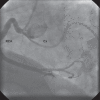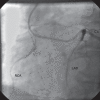The primary anomalies of coronary artery origin and course: A coronary angiographic analysis of 16,573 patients
- PMID: 23940436
- PMCID: PMC3718591
The primary anomalies of coronary artery origin and course: A coronary angiographic analysis of 16,573 patients
Abstract
Background/objectives: Coronary artery anomalies are present at birth, but relatively few are symptomatic. The majority are discovered incidentally. In the present study, coronary angiograms performed in the authors' centre (Ondokuz Mayis University Hospital, Samsun, Turkey) were analyzed to determine the prevalence and types of coronary artery origin and course anomalies.
Methods: Coronary angiographic data of 16,573 patients were analyzed. Anomalous origins and courses of coronary arteries were assessed.
Results: Anomalous coronary arteries were detected in 48 (0.29%) of 16,573 patients. The origin of the circumflex (Cx) artery from the right coronary artery (RCA) or right sinus of Valsalva was the most common anomaly (28 patients [58.3%]). An anomalous RCA originating from the left anterior descending artery (LAD) or Cx artery was observed in six patients (12.5%). The left coronary artery originated from the right sinus of Valsalva in five patients, and the LAD originated from the RCA or the right sinus of Valsalva in five patients. The RCA originated from the left sinus of Valsalva in three patients and from an ectopic ostium in the ascending aorta in one patient.
Conclusions: The most frequent anomaly observed in the present study was related to the Cx artery, which is consistent with previous reports. Although coronary artery anomalies are rare, they may cause difficulties during coronary interventions or cardiac surgery and may occasionally result in sudden cardiac death. Therefore, the recognition and diagnosis of these anomalies is important and requires specialization in coronary angiographic techniques and other imaging modalities.
Keywords: Coronary angiography; Coronary artery anomaly; Sinus of Valsalva.
Figures


References
-
- Angelini P. Coronary artery anomalies: An entity in search of an identity. Circulation. 2007;115:1296–305. - PubMed
-
- Yamanaka O, Hobbs RE. Coronary artery anomalies in 126,595 patients undergoing coronary arteriography. Cathet Cardiovasc Diagn. 1990;21:28–40. - PubMed
-
- Aydar Y, Yazici HU, Birdane A, et al. Gender differences in the types and frequency of coronary artery anomalies. Tohoku J Exp Med. 2011;225:239–47. - PubMed
-
- Ouali S, Neffeti E, Sendid K, Elghoul K, Remedi F, Boughzela E. Congenital anomalous aortic origins of the coronary arteries in adults: A Tunisian coronary arteriography study. Arch Cardiovasc Dis. 2009;102:201–8. - PubMed
LinkOut - more resources
Full Text Sources
